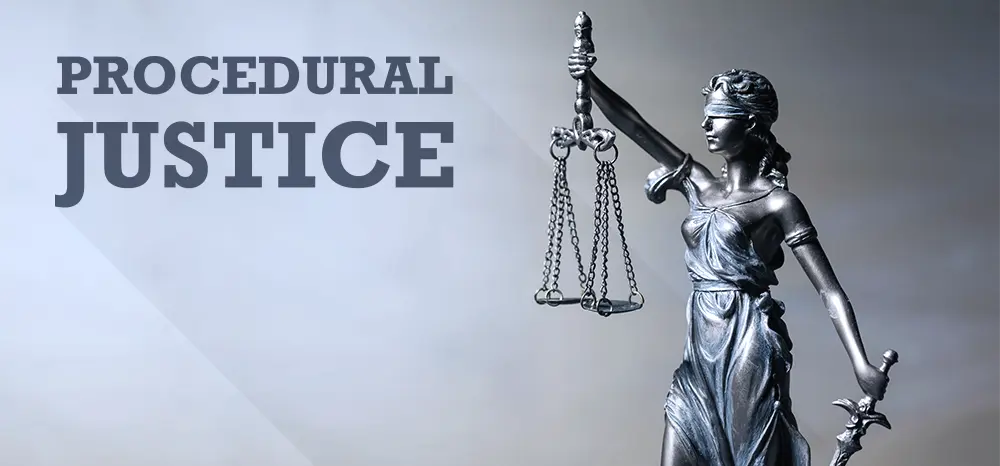
What is Procedural Justice? And How Can We Measure It?
Procedural Justice is not something I was taught or ever heard of when I was first trained as a police recruit in 2004. In more recent years, the concept of procedural justice has been introduced into police academy and in-service trainings. The concept itself revolves around a focus on how police officers treat people. While the academic definitions can feel a bit abstract, I have always found it easiest to think of in these terms: The process matters more than the outcome. So, what does that really mean? The best way I can express this is through a personal story.
When I served as a police officer, much of my time was spent on a fugitive squad, which meant we arrested and transported a large number of folks every week. My partner and I noticed that when we would drop off people at the jail, they would often say “thank you” before we left. I always found it odd that we were being thanked for bringing them to jail. So, one time, a man said “thank you!” as we started to exit the jail. I decided to stop and asked the man, “I don’t get it, I brought you to jail, what are you thanking me for?” The man replied, “Thank you for treating me like a man.” That statement always stayed with me. This was the moment when I learned what procedural justice really meant. If the process is more important than the outcome, it really means, how you treat someone is far more important than the end result. In this case, the outcome was that he was arrested and brought to jail (not a great outcome). But what mattered to him was how he was treated during the process. How he was treated mattered enough to him to proactively thank me for it. That moment changed my entire approach to the way I understand the power of the process. How I spoke to people. The words I used. The rapport I built. Common courtesy extended. All of that actually really mattered.
Many research studies have confirmed what I experienced in this moment. The way we treat people is much more important than whether they receive a ticket or get a warning. With this in mind, it suddenly becomes clear that, officers who are excellent at delivering procedural justice are likely helping to build positive relationships with the community, one interaction at a time.
But…..how do you measure this skillset?
When we developed Guardian Score, we were laser focused on helping police leaders easily measure procedural justice skills of individual police officers. The problem is, many officers, and community members, don’t know that term or really what it means. We realized we needed to deconstruct procedural justice and break it down into 5 key, measurable behaviors/traits, to make it easier for community members to provide feedback, and for police leaders to have actual data and measurements that indicate the overall level of procedural justice for an individual person. Historically, these are skills that may have been trained, but usually not measured. We wanted to change that.
The five behaviors/traits that Guardian Score measures through the community survey tool, to provide an insight into their overall procedural justice skills, (which also directly overlap with skills related to empathy and customer service) are outlined below:
Ability to Explain WHY: When people are detained by the police, they usually want to know why they have been stopped. Most community members likely don’t intuitively know about police procedures or protocols. This desire to understand why things are happening is a natural human tendency. Explaining why a police interaction is occurring, and why certain steps are being taken can have a positive impact on the interaction.
Listening Skills: A key aspect of showing respect during an interaction is by using active listening skills. This means providing an opportunity for someone to share their thoughts, feelings, or perspective.
Fairness: Sometimes it is necessary to write a ticket or make an arrest. However, treating people fairly and consistently, based on the specific circumstances can go a long way. If an enforcement action is necessary, does it match the severity of the situation?
Professionalism: Body language, the words chosen when speaking, tone of voice, even the way the uniform is worn can all impact an officer’s perceived professionalism.
Explanation of Next Steps: Many community members don’t know what to expect after a police interaction. Taking the time to explain what comes next, services available, who may follow up, or how a person can make contact, all contribute to ending an interaction on as positive of a note as possible.
As we know from research, procedural justice does have a positive impact. Training on procedural justice is a great first step. Just like with other important trainings like defensive tactics, after people train on it, agencies need to measure proficiency. Historically, measuring procedural justice, or emotional intelligence skills, or “soft” skills, was considered too complicated, or too time consuming. Thankfully, we are demystifying and simplifying the process, and it is now possible to make procedural justice less abstract, and indeed, measurable.
Ready to get started?